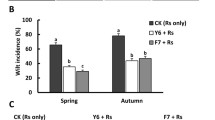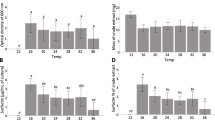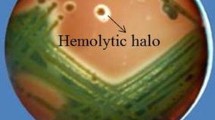Abstract
Antagonistic activity of strains from Bacillus species has made them among the preferred agricultural biological control agents against phytopathogenic fungi. These microorganisms’ success is mostly based on the production of antagonistic secondary metabolites, mainly those of the non-ribosomal cyclic lipopeptides (CLPs) nature, which can affect phytopathogens directly (iturins and fengycins) or indirectly (surfactins and fengycins). However, abiotic factors in the target site can influence the behavior of the biocontrol traits, but to date, few studies attempting to decipher this kind of interaction have been conducted. This work aimed to evaluate the effect of temperature and culture medium on growth, antagonistic activity against Fusarium oxysporum f. sp. physali (Foph), and the profile of CLPs produced by Bacillus velezensis Bs006. The data showed that measured traits in Bs006 varied with temperature and medium interaction. The concentration of CLPs, as well as the antagonistic activity against Foph, was increased as the nutritional wealth, temperature, and time of incubation increased. The concentration of fengycins and iturins was higher than surfactins at high temperatures. However, a bacteriostatic effect was detected with a combination of Landy medium and 15 °C, which prevented both the biosynthesis of CLPs and the antagonistic activity. The results of this work highlight the importance of abiotic conditions of the target site where a biocontrol agent will be applied to stay active and develop its full antagonistic potential. This response by Bs006 could partly explain the variability of its biocontrol efficacy in the Foph-golden berry pathosystem.





Similar content being viewed by others
Data Availability
The data that support the findings of this study are available from the corresponding author upon reasonable request.
References
Basu A, Prasad P, Das SN, Kalam S, Sayyed RZ, Reddy MS, El Enshasy H (2021) Plant growth promoting rhizobacteria (PGPR) as green bioinoculants: recent developments, constraints, and prospects. Sustainability 13:1140. https://doi.org/10.3390/su13031140
Lazarovits G, Turnbull A, Johnston-Monje D (2014) Plant health management: biological control of plant pathogens. Encycl Agric Food Syst 4:388–399. https://doi.org/10.1016/b978-0-444-52512-3.00177-7
Emmert EAB, Handelsman J (1999) Biocontrol of plant disease: a gram-positive perspective. FEMS Microbiol Lett 171:1–9. https://doi.org/10.1111/j.1574-6968.1999.tb13405.x
Raaijmakers JM, de Bruijn I, Nybroe O, Ongena M (2010) Natural functions of lipopeptides from Bacillus and Pseudomonas: more than surfactants and antibiotics. FEMS Microbiol Rev 34:1037–1062. https://doi.org/10.1111/j.1574-6976.2010.00221.x
Kloepper JW, Ryu CM, Zhang S (2004) Induced systemic resistance and promotion of plant growth by Bacillus spp. Phytopathology 94:1259–1266. https://doi.org/10.1094/PHYTO.2004.94.11.1259
Cawoy H, Mariutto M, Henry G, Fisher C, Vasilyeva N, Thonart P, Dommes J, Ongena M (2014) Plant defense stimulation by natural isolates of Bacillus depends on efficient surfactin production. Mol Plant Microbe Interact 27:87–100. https://doi.org/10.1094/MPMI-09-13-0262-R
Dunlap CA, Bowman MJ, Schisler DA (2013) Genomic analysis and secondary metabolite production in Bacillus amyloliquefaciens AS 43.3: a biocontrol antagonist of Fusarium head blight. Biol Control 64:166–175. https://doi.org/10.1016/j.biocontrol.2012.11.002
Compant S, Duffy B, Nowak J, Clément C, Barka EA (2005) Use of plant growth-promoting bacteria for biocontrol of plant diseases: principles, mechanisms of action, and future prospects. Appl Environ Microb 71:4951–4959. https://doi.org/10.1128/AEM.71.9.4951-4959.2005
Thomashow LS (1996) Biological control of plant root pathogens. Curr Opin Biotech 7:343–347. https://doi.org/10.1016/S0958-1669(96)80042-5
Akpa E, Jacques P, Wathelet B, Paquot M, Fuchs R, Budzikiewicz H, Thonart P (2001) Influence of culture conditions on lipopeptide production by Bacillus subtilis. Appl Biochem Biotech 91:551–561. https://doi.org/10.1385/ABAB:91-93:1-9:551
Das P, Mukherjee S, Sen R (2009) Substrate dependent production of extracellular biosurfactant by a marine bacterium. Bioresource Technol 100:1015–1019. https://doi.org/10.1016/j.biortech.2008.07.015
Chen M, Wang J, Liu B, Zhu Y, Xiao R, Yang W, Ge C, Chen Z (2020) Biocontrol of tomato bacterial wilt by the new strain Bacillus velezensis FJAT-46737 and its lipopeptides. BMC Microbiol 20:160. https://doi.org/10.1186/s12866-020-01851-2
Singh AK, Rautela R, Cameotra SS (2014) Substrate dependent in vitro antifungal activity of Bacillus sp. strain AR2. Microb Cell Fact 13:67–77. https://doi.org/10.1186/1475-2859-13-67
Yaseen Y, Gancel F, Béchet M, Drider D, Jacques P (2017) Study of the correlation between fengycin promoter expression and its production by Bacillus subtilis under different culture conditions and the impact on surfactin production. Arch Microbiol 199:1371–1382. https://doi.org/10.1007/s00203-017-1406-x
Peypoux F, Michel G (1992) Controlled biosynthesis of Val7-and Leu7-surfactins. Appl Microbiol Biotechnol 16:515–517. https://doi.org/10.1007/BF00170194
Coutte F, Lecouturier D, Dimitrov K, Guez J-S, Delvigne F, Dhulster P, Jacques P (2017) Microbial lipopeptide production and purification bioprocesses, current progress and future challenges. Biotechnol J 12:1600566. https://doi.org/10.1002/biot.201600566
Malviya D, Sahu PK, Singh UB, Paul S, Gupta A, Gupta AR, Singh S, Kumar M, Paul D, Rai JP, Singh HV, Brahmaprakash GP (2020) Lesson from ecotoxicity: revisiting the microbial lipopeptides for the management of emerging diseases for crop protection. Int J Environ Res Public Health 17:1434. https://doi.org/10.3390/ijerph17041434
Moreno-Velandia CA, Izquierdo-García LF, Ongena M, Kloepper JW, Cotes AM (2019) Soil sterilization, pathogen and antagonist concentration affect biological control of Fusarium wilt of cape gooseberry by Bacillus velezensis Bs006. Plant Soil 435:39–55. https://doi.org/10.1007/s11104-018-3866-4
Landy M, Warren GH, Rosenman SB, Colio LG (1948) Bacillomycin, an antibiotic from Bacillus subtilis active against pathogenic fungi. Proc Soc Exp Biol Med 67:539–541
Leclère V, Béchet M, Adam A, Guez J-S, Wathelet B, Ongena M, Thonart P, Gancel F, Chollet-Imbert M, Jacques P (2005) Mycosubtilin overproduction by Bacillus subtilis BBG100 enhances the organism’s antagonistic and biocontrol activities. Appl Environ Microb 71:4577–4584. https://doi.org/10.1128/AEM.71.8.4577-4584.2005
Leclère V, Marti R, Béchet M, Fickers P, Jacques P (2006) The lipopeptides mycosubtilin and surfactin enhance spreading of Bacillus subtilis strains by their surface-active properties. Arch Microbiol 186:475–483. https://doi.org/10.1007/s00203-006-0163-z
Scholz R, Molohon KJ, Nachtigall J, Vater J, Markley AL, Süssmuth RD, Mitchell DA, Borriss R (2011) Plantazolicin, a novel microcin B17/streptolysin S-like natural product from Bacillus amyloliquefaciens FZB42. J Bacteriol 193:215–224. https://doi.org/10.1128/JB.00784-10
Scholz R, Vater J, Budiharjo A, Wang Z, He Y, Dietel C, Schwecke T, Herfort S, Lasch P, Borriss R (2014) Amylocyclicin, a novel circular bacteriocin produced by Bacillus amyloliquefaciens FZB42. J Bacteriol 196:1842–1852. https://doi.org/10.1128/JB.01474-14
Moreno-Velandia CA, Ongena M, Cotes AM (2021) Effects of fengycins and iturins on Fusarium oxysporum f. sp. physali and root colonization by Bacillus velezensis Bs006 protect golden berry against vascular wilt. Phytopathology. https://doi.org/10.1094/PHYTO-01-21-0001-R
Guacaneme A (2010) Biocontrol de Fusarium oxysporum y promoción de crecimiento por rizobacterias en plantas de uchuva (Physalis peruviana) Trabajo de Pregrado. Microbiología. Universidad de los Andes, Bogotá, p 11
Torres EL (2013) Determinación del efecto de Pseudomonas migulae Pf014 y Bacillus amyloliquefaciens Bs006 aplicadas de forma individual y en mezclas sobre la promoción de crecimiento y el control de Fusarium oxysporum en uchuva (Physalis peruviana). Trabajo de Maestría en Biotecnología. Universidad de Córdoba, Montería
Wulff EG, Mguni CM, Mansfeld-Giese K, Fels J, Lübeck M, Hockenhull J (2002) Biochemical and molecular characterization of Bacillus amyloliquefaciens, B. subtilis, and B. pumilus isolates with distinct antagonistic potential against Xanthomonas campestris pv. campestris. Plant Pathol 51:574–584. https://doi.org/10.1046/j.1365-3059.2002.00753.x
Raaijmakers JM, Vlami M, de Souza JT (2002) Antibiotic production by bacterial biocontrol agents. Antonie van Leeuwenhoek 81:537–547. https://doi.org/10.1023/A:1020501420831
Burpee LL (1990) The influence of abiotic factors on biological control of soilborne plant pathogenic fungi. Can J Plant Pathol 12:308–317. https://doi.org/10.1080/07060669009501005
Abushady HM, Bashandy AS, Aziz NH, Ibrahim HMM (2005) Molecular characterization of Bacillus subtilis surfactin producing strain and the factors affecting its production. Int J Agric Biol 7:337–344
Fickers P, Leclère V, Guez J-S, Béchet M, Coucheney F, Joris B, Jacques P (2008) Temperature dependence of mycosubtilin homologue production in Bacillus subtilis ATCC6633. Res Microbiol 159:449–457. https://doi.org/10.1016/j.resmic.2008.05.004
Krebs B, Höding B, Kübart S, Workie MA, Junge H, Schmiedeknecht G, Grosch R, Bochow H, Hevesi M (1998) Use of Bacillus subtilis as biocontrol agent. I. Activities and characterization of Bacillus subtilis strains. J Plant Dis Protect 105:181–197
Landa BB, Navas-Cortés JA, Jiménez-Díaz RM (2004) Influence of temperature on plant–rhizobacteria interactions related to biocontrol potential for suppression of fusarium wilt of chickpea. Plant Pathol 53:341–352. https://doi.org/10.1111/j.0032-0862.2004.01008.x
Pereira F, Vasconcelos F, Ongena M, de Franzil L, Souza P, de Souza J (2016) Effect of temperature, pH and substrate composition on production of lipopeptides by Bacillus amyloliquefaciens 629. Afr J Microbiol Res 10:1506–1512. https://doi.org/10.5897/AJMR2016.8222
Pertot I, Puopolo G, Hosni T, Pedrotti L, Jourdan E, Ongena M (2013) Limited impact of abiotic stress on surfactin production in planta and on disease resistance induced by Bacillus amyloliquefaciens S499 in tomato and bean. FEMS Microbiol Ecol 86:505–519. https://doi.org/10.1111/1574-6941.12177
Sezonov G, Joseleau-Petit D, D’Ari R (2007) Escherichia coli physiology in Luria-Bertani Broth. J Bacteriol 189:8746–8749. https://doi.org/10.1128/JB.01368-07
Argüelles-Arias A, Ongena M, Halimi B, Lara Y, Brans A, Joris B, Fickers P (2009) Bacillus amyloliquefaciens GA1 as a source of potent antibiotics and other secondary metabolites for biocontrol of plant pathogens. Microb Cell Fact 8:63. https://doi.org/10.1186/1475-2859-8-63
Chen XH, Scholz R, Borris M, Junge H, Mögel G, Kunz S, Borriss R (2009) Difficidin and bacilysin produced by plant-associated Bacillus amyloliquefaciens are efficient in controlling fire blight disease. J Biotechnol 140:38–44. https://doi.org/10.1016/j.jbiotec.2008.10.015
Nihorimbere V, Fickers P, Thonart P, Ongena M (2009) Ecological fitness of Bacillus subtilis BGS3 regarding production of the surfactin lipopeptide in the rhizosphere. Environ Microbiol Rep 1:124–130. https://doi.org/10.1111/j.1758-2229.2009.00017.x
Yu GY, Sinclair JB, Hartman GL (2002) Bertagnolli BL: production of iturin A by Bacillus amyloliquefaciens suppressing Rhizoctonia solani. Soil Biol Biochem 34(955):963. https://doi.org/10.1016/S0038-0717(02)00027-5
Chen M, Wang J, Zhu Y, Liu B, Yang W, Ruan C (2019) Antibacterial activity against Ralstonia solanacearum of the lipopeptides secreted from the Bacillus amyloliquefaciens strain FJAT-2349. J Appl Microbiol 126:1519–1529. https://doi.org/10.1111/jam.14213
Willenbacher J, Yeremchuk W, Mohr T, Syldatk C, Hausmann R (2015) Enhancement of surfactin yield by improving the medium composition and fermentation process. AMB Express 5:57–65. https://doi.org/10.1186/s13568-015-0145-0
Acknowledgements
The strains B. velezensis Bs006 and F. oxysporum f. sp. physali Map5 from AGROSAVIA Microorganisms Working Collection were evaluated in the research that gave rise to this paper. The authors acknowledge Laurent Franzil by technical support in the chromatography laboratory, and Drs. Felipe Borrero Echeverry and Andrea Paola Zuluaga by critical review of the manuscript.
Funding
C.A. Moreno-Velandia’s thesis was supported by commission studies for doctorate program from the Corporación Colombiana de Investigación Agropecuaria (AGROSAVIA) and a grant from Programa Nacional de Formación de Investigadores, Becas Colciencias, Colombia, Doctorado Nacional 567. This research was funded by AGROSAVIA and Ministerio de Agricultura y Desarrollo Rural through TV15 and TV16 agreements for the development of project 687. Microbial Processes and Interactions Laboratory, at Gembloux Agro-Bio Tech, University of Liege also contributed for the development of this work.
Author information
Authors and Affiliations
Contributions
CAM-V: conceptualization, methodology, investigation, formal analysis, and writing—original draft. MO: conceptualization, methodology, resources, and writing—review & editing. JWK: writing—review & editing. AMC: conceptualization, writing—review & editing, supervision, project administration, and funding acquisition.
Corresponding author
Ethics declarations
Conflict of interest
The authors declare that they have no known competing financial interests or personal relationships that could have appeared to influence the work reported in this paper.
Additional information
Publisher's Note
Springer Nature remains neutral with regard to jurisdictional claims in published maps and institutional affiliations.
Supplementary Information
Below is the link to the electronic supplementary material.
Rights and permissions
About this article
Cite this article
Moreno-Velandia, C.A., Ongena, M., Kloepper, J.W. et al. Biosynthesis of Cyclic Lipopeptides by Bacillus velezensis Bs006 and its Antagonistic Activity are Modulated by the Temperature and Culture Media Conditions. Curr Microbiol 78, 3505–3515 (2021). https://doi.org/10.1007/s00284-021-02612-8
Received:
Accepted:
Published:
Issue Date:
DOI: https://doi.org/10.1007/s00284-021-02612-8




